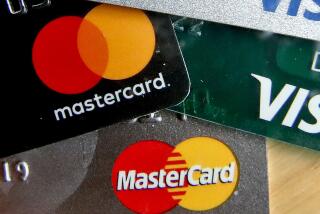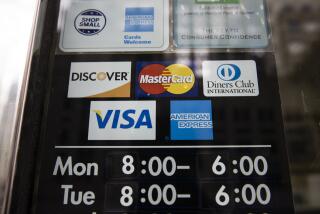Image, Reality and the Green Charge Card
American Express Co. is trotting respected New York economist Allen Sinai across the country to preach a simple message: Pay off your high-cost credit card debt.
Debt is bad for the economy, Sinai notes. That’s because Americans are paying billions in interest charges and getting nothing new in return. Interest paid on outstanding debt enriches banks, but does not increase employment or buy you usable goods and services.
All this, of course, is true. But why is American Express spending tens of thousands of dollars to push the message?
The company says it is part of a public service campaign that could help consumers and the economy. American Express’ profit is largely dependent on consumer spending, so a more robust economy would help them too, a spokeswoman says.
However, the campaign is also a subtle form of image advertising, industry experts say. The idea is that people will walk away believing that American Express is one of the corporate good guys, concerned about consumers’ financial health. That might make them more inclined to apply for one of the company’s charge or credit cards.
Is American Express one of the good guys? Sure. Regardless of the impetus, giving consumers more information is a nice thing to do. And the message about debt is something like cod liver oil--hard to swallow, but probably good for you.
Still, being a good guy doesn’t prohibit you from peddling some unattractive products. And the company’s green card is a good example.
The green card is a “charge” card. That’s different than a credit card because it doesn’t allow long-term credit. What it offers is the ability to charge a purchase in emergency or when it’s convenient. But you’ve got to pay off your balance each and every month.
In theory, you can charge as much as you’d like on an American Express green card. There’s no set limit. But, in practice, you can only charge as much as you can pay off in one fell swoop. For most people, that’s very limiting.
Nevertheless, since the green card doesn’t offer credit, there’s no interest charges. In practice, however, some time passes while you and American Express exchange mail. That means you actually get up to 50 days of free credit--or, in industry jargon, “float”--with the green card.
If you don’t pay your bill within 50 days, however, American Express says it will slap you with a fee equal to 2.5% of your balance or $20, whichever is higher.
What does this convenience and float cost you? A bit more than $3 a month, or $55 annually. That’s not much really. But why pay $55 when you can get almost the same thing for free?
More than 50 banks issue no-fee credit cards, according to the CardTrak, a monthly credit card survey conducted by Ram Research Corp. of Frederick, Md. The bulk of them give you a 25-day grace period. In other words, if you pay off the balance each month, you pay no interest on charges less than 25 days old.
So all your green American Express card is getting you is a slightly longer grace period. Unless you charge thousands of dollars monthly and habitually use that extra 20 or 25 days, that’s not much extra value.
However, the economics of American Express’ credit card, the Optima, can be a bit better.
If you already have a green card, American Express will give you an Optima card with a $15 annual fee. (That is in addition to the $55 you’ve already paid for the green card.) A better deal is to apply for the Optima solo. Then the fee is $25 annually.
If you charge a lot and pay your bills on time, Optima’s interest rate is relatively attractive. To be specific, those who charge at least $1,000 per month and who make at least the minimum payment within the allotted time, every time, get a variable rate that floats 6 percentage points above prime. That makes it 12% today.
Those with less substantial charges or the occasional late payment, get a 14.25% rate--8.25 percentage points over prime. The rate rises to 18.25% for habitual late payers.
How does this compare to the competition? Fairly well.
The average credit-card interest rate is now 17.98% and the average annual fee is a few pennies above $17, according to Ram.
However, most major issuers offer different rates depending on how good a risk (or customer) you are. Eight out of the top 10 bank card companies say their best rate is 14.9% or more. The high-end rates range from 15.9% to 21.9%. So the Optima card’s interest rates are in the low end of the range.
The Optima’s annual fee may be annoying, but it is not a significant factor when it comes to costs, assuming the card holder keeps a revolving balance.
If you figure that a customer maintains a $2,000 revolving balance, the total annual cost of the 12% card is about $265 (including the $25 annual fee) versus about $300 for a 15% no-fee card.
More to Read
Inside the business of entertainment
The Wide Shot brings you news, analysis and insights on everything from streaming wars to production — and what it all means for the future.
You may occasionally receive promotional content from the Los Angeles Times.










